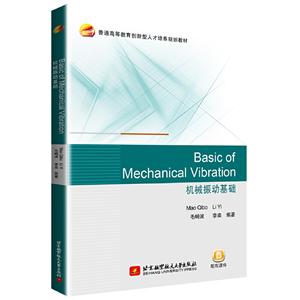-
>
中医基础理论
-
>
高校军事课教程
-
>
思想道德与法治(2021年版)
-
>
毛泽东思想和中国特色社会主义理论体系概论(2021年版)
-
>
中医内科学·全国中医药行业高等教育“十四五”规划教材
-
>
中医诊断学--新世纪第五版
-
>
中药学·全国中医药行业高等教育“十四五”规划教材
机械振动基础 版权信息
- ISBN:9787512431492
- 条形码:9787512431492 ; 978-7-5124-3149-2
- 装帧:平装-胶订
- 册数:暂无
- 重量:暂无
- 所属分类:>>
机械振动基础 本书特色
Abstract
This book mainly describes vibration problems for linear discrete and continuous systems inengineering. This book provides the background and techniques for modeling, analysis, design, andcontrol of vibration in mechanical engineering systems. This book is organized into 6 chapters,
including introduction, free vibration of single-degree-of-freedom (SDOF) systems, harmonicexcitation of SDOF systems, vibration of SDOF systems under general excitation, vibration ofmultiple-degree-of-freedom systems and vibration of continuous systems. Some backgroundmaterials (such as mathematical background, basic of MATLAB, Laplace transform and technicalterms) are presented in the appendices.
This book focuses on the linear vibration problems and emphasizes the ability to solveengineering vibration problems by using MATLABsoftware.Numerous examples and problemshave been included both to assist the student in mastering the material and to demonstrate theapplicability of the methods of analysis used in the book.Abstract
This book mainly describes vibration problems for linear discrete and continuous systems inengineering. This book provides the background and techniques for modeling, analysis, design, andcontrol of vibration in mechanical engineering systems. This book is organized into 6 chapters,
including introduction, free vibration of single-degree-of-freedom (SDOF) systems, harmonicexcitation of SDOF systems, vibration of SDOF systems under general excitation, vibration ofmultiple-degree-of-freedom systems and vibration of continuous systems. Some backgroundmaterials (such as mathematical background, basic of MATLAB, Laplace transform and technicalterms) are presented in the appendices.
This book focuses on the linear vibration problems and emphasizes the ability to solveengineering vibration problems by using MATLABsoftware.Numerous examples and problemshave been included both to assist the student in mastering the material and to demonstrate theapplicability of the methods of analysis used in the book.
This book is suitable as a course textbook in a single-semester course for second-year or thirdyearundergraduate students, or for Master degree candidate in any branch of engineering such asaeronautical and aerospace, aircraft design, and mechanical engineering. The book can also serve asa valuable reference tool for practicing engineers with an interest in vibration problems.
机械振动基础 内容简介
该书为英文版《机械振动基础》,主要讲述机械振动的基本理论。全书共分为六章,包括绪论、单自由度系统的自由振动、单自由度系统的简谐受迫振动、单自由度系统的任意受迫振动、多自由度系统的振动、连续系统振动,并包括“数学基础”、“MATLAB基础”、“Laplace变换”和“中英文术语对照”四个附录。 本书强调线性振动问题,理论循序渐进,并配有大量的例题、习题和MATLAB算例。本书可作为高等院校的航空航天、机械、能动或土木等专业本科生或者研究生教材,也可供相关的工程人员自学使用。
机械振动基础 目录
- >
罗曼·罗兰读书随笔-精装
罗曼·罗兰读书随笔-精装
¥20.3¥58.0 - >
新文学天穹两巨星--鲁迅与胡适/红烛学术丛书(红烛学术丛书)
新文学天穹两巨星--鲁迅与胡适/红烛学术丛书(红烛学术丛书)
¥9.9¥23.0 - >
我从未如此眷恋人间
我从未如此眷恋人间
¥24.4¥49.8 - >
【精装绘本】画给孩子的中国神话
【精装绘本】画给孩子的中国神话
¥19.3¥55.0 - >
上帝之肋:男人的真实旅程
上帝之肋:男人的真实旅程
¥19.3¥35.0 - >
烟与镜
烟与镜
¥24.0¥48.0 - >
有舍有得是人生
有舍有得是人生
¥17.1¥45.0 - >
唐代进士录
唐代进士录
¥25.5¥39.8
-
食品添加剂
¥33.5¥45 -
VB语言程序设计
¥29.9¥39.8 -
C语言程序设计习题与实验指导
¥9.1¥18 -
地下建筑结构-(第三版)-(赠课件)
¥49.4¥55 -
模具制图
¥37.8¥49 -
工程机械结构认知
¥10.5¥22





















